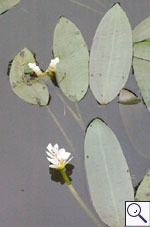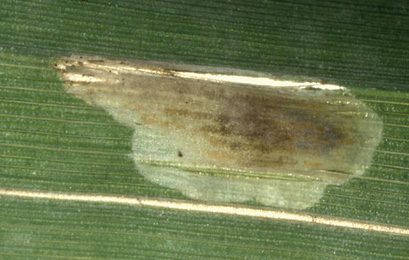|
||||||
|
POTAMOGETON. Pondweeds. [Potamogetonaceae] |
|
|
Forty-one species and numerous hybrids of Potamogeton are recorded in Britain. All are native and include Shining Pondweed (P. lucens), Broad-leaved Pondweed (P. natans) and Bog Pondweed (P. polygonifolius). The BSBI provide a downloadable plant crib for Potamogeton and Ruppia. Eight British miners are recorded on Potamogeton. The crambid Parapoynx stratiotata feeds between spun leaves of Potamogeton elsewhere. A key to the European miners recorded on Potamogeton is provided in Bladmineerders van Europa. |
|
Key for the identification of the known mines of British Diptera recorded on Potamogeton |
Note: Diptera larvae may live in a corridor mine, a corridor-blotch mine, or a blotch mine, but never in a case, a rolled or folded leaf, a tentiform mine or sandwiched between two more or less circular leaf sections in later instars. Pupation never in a cocoon. All mining Diptera larvae are leg-less maggots without a head capsule (see examples). They never have thoracic or abdominal legs. They do not have chewing mouthparts, although they do have a characteristic cephalo-pharyngeal skeleton (see examples), usually visible internally through the body wall. The larvae lie on their sides within the mine and use their pick-like mouthparts to feed on plant tissue. In some corridor miners frass may lie in two rows on alternate sides of the mine. In order to vacate the mine the fully grown larva cuts an exit slit, which is usually semi-circular (see Liriomyza huidobrensis video). The pupa is formed within the hardened last larval skin or puparium and as a result sheaths enclosing head appendages, wings and legs are not visible externally (see examples). See Key to non-Diptera. |
1a > Tunnel-like mine, open at both ends |
1b > Leaf-mine |
2a > Tunneler: The larvae of a number of species of Chironomidae (non-biting midges) live in tunnels in decaying leaf sheaths under water. Their tunnels are open at both ends, and the larvae feed on particles they obtain from a water current they create in the tunnels. They do not feed on tissues of their 'hostplant' and therefore are not strictly miners. |
|
Cricotopus trifasciatus (Meigen, 1813) [Diptera: Chironomidae]. |
2b > Tunneler: Tunnel follows erratic routes; the larva leaves the tunnel occasionally and recommences tunneling elsewhere in the same leaf or another leaf; at the termination of some of the mines a special double-walled chamber is constructed, possibly for moulting (Bland and Rotheray, 1994: 34). The larvae of a number of species of Chironomidae (non-biting midges) live in tunnels in decaying leaf sheaths under water. Their tunnels are open at both ends, and the larvae feed on particles they obtain from a water current they create in the tunnels. They do not feed on tissues of their 'hostplant' and therefore are not strictly miners. |
|
Cricotopus brevipalpis (Kieffer, 1909) [Diptera: Chironomidae]. |
2c > Tunneler: Half-mine; a one cm long straight tunnel along the midline of the upperside of the leaf; larva rests in this retreat during the day, emerging to devour the upper epidermis of the leaf during the hours of darkness. Feeding occurs from both ends of the retreat to a similar degree (Bland, 1994a). The larvae of a number of species of Chironomidae (non-biting midges) live in tunnels in decaying leaf sheaths under water. Their tunnels are open at both ends, and the larvae feed on particles they obtain from a water current they create in the tunnels. They do not feed on tissues of their 'hostplant' and therefore are not strictly miners. |
|
Cricotopus tricinctus (Meigen, 1818) [Diptera: Chironomidae]. |
| 3# > ? Leaf-miner: Details of mine unknown. |
|
Hydrellia albilabris Meigen, 1830 [Diptera: Ephydridae]. |
3a > Leaf-miner: Narrow corridor, leading to a large blotch. The blotch has lower- and upper-surface parts, and is full depth where these overlap. Pupation external (Robbins, 1991a). |
|
| Scaptomyza griseola (Zetterstedt, 1847) [Diptera: Drosophilidae]. |
| 3b > Leaf-miner: Irregular mine, locally shallow, elsewhere much deeper, giving it a mottled appearance. In broadleaved plants the mine often begins as a blotch with stellate extensions, but sometimes as a very fine, shallow corridor. In grasses the mine often begins in the leaf sheath. The frass is very fine-grained, initially scattered, later in aggregates. The egg is deposited on the plant surface, and the empty egg shell remains visible. But the larvae are able to leave their mine and restart elsewhere, thus mines without an egg shell can be found as well. The larva also leaves the mine before pupation. Pupation takes place in a newly made, small, blotch mine without frass; this mine may be made in another plant (species). |
|
|
Hydrellia griseola (Fallén, 1813) [Diptera: Ephydridae]. |
|
Key for the identification of the known mines of British |
Note: The larvae of mining Coleoptera, Hymenoptera and Lepidoptera may live in a corridor mine, a corridor-blotch mine, a blotch mine, a case, a rolled or folded leaf, a tentiform mine or sandwiched between two more or less circular leaf sections in later instars. Larva may pupate in a silk cocoon. The larva may have six legs (although they may be reduced or absent), a head capsule and chewing mouthparts with opposable mandibles (see video of a gracillarid larva feeding). Larvae of Hymenoptera and Lepidoptera usually also have abdominal legs (see examples). Frass, if present, never in two rows. Unless feeding externally from within a case the larva usually vacates the mine by chewing an exit hole. Pupa with visible head appendages, wings and legs which lie in sheaths (see examples). |
1a > Leaf-miner: Full depth or lower-surface blotch, usually near the attachement of the petiole. Older larvae do not mine any longer but live in a flat case, made out of leaf fragments, and cause window feeding at the leaf underside. It mines the leaf for the first three days and then forms a flat case from which the larva feeds. |
|
| Elophila nymphaeata (Linnaeus, 1758) [Lepidoptera: Crambidae]. |
1b > Leaf-miner: When young, the larva mines mainly the leaves or the stem of Sparganium or Nuphar lutea. It hibernates. Later it lives amongst spun leaves just below the surface of the water. Pupation in a white silk cocoon attached to the foodplant at or just below the water-level (Belgian Lepidoptera). Long narrow corridor, on or alongside the midrib. The corridor may descend below the water surface, and does contain frass. After some time the larva cuts itself a case out of the mine, and continues living free, partly under water. |
|
Nymphula nitidulata (Hufnagel, 1767) [Lepidoptera: Crambidae]. |
| Last updated 06-Jul-2019 Brian Pitkin | ||


